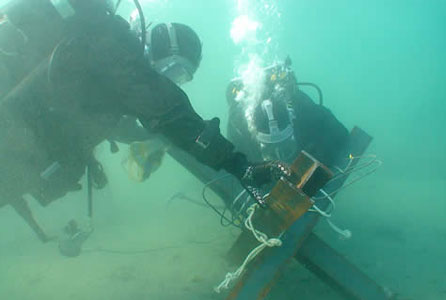
Underwater Demolition
Not all structures are buildings and not all demolition jobs are dry. When underwater oil rigs must be demolished or if there are naturally occurring geological rock formations in the way of getting to precious ores and minerals, underwater demolition is the best way to the job done quickly. Not all underwater demolition can be done using explosives though there are indeed charges that can be set and detonated underwater. Typically, for projects involving getting through bedrock in order to reach useable ores and materials, a demolition process involving a substance called Dexpan is used. Depending on the circumstance, underwater demolition can take several forms.
Skilled Divers
Regardless of the type of underwater demolition project you have on your hands, skilled divers are going to be necessary. Because demolition projects last days and sometimes even weeks depending on how much area of bedrock must be removed or how large the oil rig is that’s being destroyed, divers with thousands of logged hours underwater are hired and typically they’ll need experience in demolition before they’ll even be considered. Some of the best candidates for underwater demolition diving include former Navy SEALs. Considered the most elite fighting force on the planet, the SEAL’s began as an amphibious underwater demolition team and to this day are trained on how to withstand long hours in freezing water while drilling, setting and placing charges and staying safe through detonation. Other candidates that make great divers for this type of project include demolition experts that are scuba certified with plenty of experience in the water.
Waterproof Explosives
Because some underwater demolition projects don’t require delicacy, waterproof explosives have been devised that make use of different compounds that encase explosive material within inorganic, oxidizing salts, fuel oil and a couple other elements that protect the explosive material from getting wet. Imagine a cell with its nucleus in the middle and its cellular skin protecting and holding in the nucleus. This is a great way of visualizing how explosive material is protected within an underwater explosive compound. Molecules known as polygalactomannans and crosslinkers are present in the compound and when exposed to water, they form a gelatinous material that becomes rigid like a cell’s skin. The explosive material, like the nucleus of a cell is encased within the gel and protected from saturation allowing for effective combustion and explosion.
Practical Applications
As stated, underwater demolition is widely used to:
- Clear areas of bedrock that blocks access to minerals and ores that can be harvested and made into finished materials like iron.
- Excavate for structures that exist underwater. Though specialized, these projects do account for some demolitions overall.
- Take down both oilrigs and underwater research facilities that may eventually need to be demolished to return the sea to its original condition. When it comes to materials used for underwater structures, chemical processes like oxidation of iron can leave toxic chemicals behind that devastate sea life if not properly demolished and then carted away.
